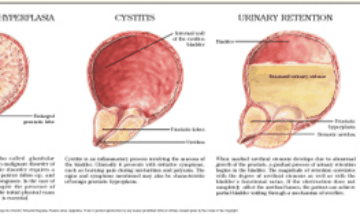When it comes to prostate health, awareness is the first step in managing potential problems. The medical field designates BPH as part of a set of conditions with common symptoms termed Lower Urinary Tract Symptoms (LUTS). While the symptoms of Enlarged Prostate, also known as benign prostatic hyperplasia (BPH) are similar to prostate cancer, it is not the same type of condition. The operative word is “benign” so that means non-cancerous. Since there are several conditions with the same symptoms that affect this area of the body, the testing process will reveal the issues and determine the course of treatment.
Factors In The Development of Enlarged Prostate
 Statistics show that the most common circumstance for the development of Enlarged Prostate (BPH) is aging. Hormone issues are another major aspect of BPH. It involves the excessive production of several hormones and most particularly, the conversion of testosterone into dihydrotestosterone (DHT).
Statistics show that the most common circumstance for the development of Enlarged Prostate (BPH) is aging. Hormone issues are another major aspect of BPH. It involves the excessive production of several hormones and most particularly, the conversion of testosterone into dihydrotestosterone (DHT).
This causes the enlargement of the prostate gland as well as the accumulation of fats in the prostate area, which adds to the pressure on the prostate and bladder.
Environment and lifestyle choices, like nutrition and exercise, can have a negative or positive impact on general prostate health. Research shows that people living in Asia have a lower incidence of Enlarged Prostate (BPH). However Asians who migrate to North America develop the condition at the same high rates as other North Americans. The Asian diet is assumed to be a factor in producing those statistics since high consumption of soy is commonly understood as having a beneficial effect on the hormonal imbalances that lead to Enlarged Prostate (BPH).
Major Symptoms Of Enlarged Prostate
The primary symptom of Enlarged Prostate (BPH) is difficulty in urinating, which can range from mild to severe. There might be difficulty in starting and stopping the flow of urine, pain during urination, frequent urination all through the day and even at night, interrupting sleep. There may also be a strong urge to urinate even just after urinating.
Arriving At A Diagnosis
 In a general medical exam, if the patient has reached the age of 40, the doctor will likely be looking into the patient’s prostate health as a matter of course. This involves reviewing the patient’s complete medical history, along with a digital rectal exam and having blood and urine tests done. If there is a potential for prostate problems, the doctor will likely be ordering an ultrasound imaging test as well. By this time, the doctor may have pulled out his International Prostate Symptom Scale (ISPS) to help diagnose the severity of the symptoms. The ISPS takes into account aspects of the patient’s medical history and the degree to which the symptoms affect daily life. Taken all together, the physician will arrive at a diagnosis of Enlarged Prostate (BPH), if it exists, and determine the course of treatment.
In a general medical exam, if the patient has reached the age of 40, the doctor will likely be looking into the patient’s prostate health as a matter of course. This involves reviewing the patient’s complete medical history, along with a digital rectal exam and having blood and urine tests done. If there is a potential for prostate problems, the doctor will likely be ordering an ultrasound imaging test as well. By this time, the doctor may have pulled out his International Prostate Symptom Scale (ISPS) to help diagnose the severity of the symptoms. The ISPS takes into account aspects of the patient’s medical history and the degree to which the symptoms affect daily life. Taken all together, the physician will arrive at a diagnosis of Enlarged Prostate (BPH), if it exists, and determine the course of treatment.
Enlarged Prostate (BPH) is an inevitable part of aging for many men, but with minor lifestyle adaptations, it is possible to stay a step ahead of potential prostate difficulties.











